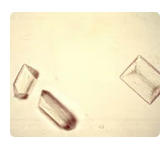The identification of the crystals depicted in this image are triple phosphate crystals. Triple
phosphate crystals may be normal but are usually associated with alkaline urine. These
colorless crystals have a characteristic "coffin lid" appearance.
What is the identification of these crystals seen in urine with an alkaline pH?
A. Uric acid
B. Calcium oxalate
C. Triple phosphate
D. Calcium carbonate
Medical ethics
A. Includes situational ethics
B. has strict guidelines
C. Applies to laboratory professionals and includes situational ethics
D. Applies to laboratory professionals
Which of the following disorders is characterized by increased production of chloride in
sweat?
Multiple myeloma
A. Hypoparathyoidism
B. Cystic fibrosis
C. Wilson's disease
D. Down Syndrome
Charcot-Leyden crystals in stool are thought to be created from damaged eosinophil
byproducts. These crystals have a strong association, although they are rare, with parasitic
infections or allergic reactions.
Charcot-Leyden crystals in stool may be associated with an immune response and are
thought to be the breakdown products of:
A. neutrophils
B. eosinophils
C. monocytes
D. lymphocytes
E. basophils
Beer's law is based on the fact that absorbance is directly proportional to the concentration of a solution. Therefore, stray light can alter the absorbance results in this type of assay. Deviations from Beer's Law are caused by:
A. very low concentration of absorbing material
B. polychromatic light
C. very high concentrations of substance being measured in a colorimetric reaction
D. stray light
Which method remains the "gold standard" for ANA detection?
A. Radioimmunoassay (RIA)
B. Lateral Flow Immunoassay
C. Enzyme Immunoasay (ELISA)
D. Slide-based immunofluorescent assay (IFA) or Colorzyme
FFP that has been thawed at 30 - 37oC and maintained at 1 - 6oC must be transfused
within 24 hours. In contrast, "Thawed Plasma" can be used for up to 5 days as a
replacement therapy for patients requiring stable clotting factors. Keep in mind that these
are two different component types and you are asked about FFP.
Blood Bank
FFP that has been thawed at 30 - 37oC and maintained at 1 - 6oC must be transfused
within ___________ after it has been thawed.
A. 24 hours
B. 8 hours
C. 12 hours
D. 5 days
E. 10 days
What two glycoproteins are expressed on the surface of influenza A viruses and are used for subtyping of the viruses?
A. Hemagglutinin
B. Glycoprotein120 (gp120)
C. Glycoprotein41 (gp41)
D. Neuraminidase
A test with high specificity accurately detects the absence of disease. The more specific a
test is, the fewer false-positive results will occur. A test with high sensitivity accurately
identifies the presence of disease. The more sensitive a test, the fewer false-negative
results it produces. In the case stated in this question, the immunoassay has high
specificity, so it has few false-positives and will accurately detect those individuals who do
not have the disease or condition that is being tested for. However, the test has low
sensitivity, so it may not identify all individuals who actually have the disease; it may
produce many false-negative results.
The accuracy of an immunoassay is its ability to discriminate between results that are true
positives and results that are true negatives. Two parameters of test accuracy are
specificity and sensitivity. Which of these statements apply to an immunoassay with high
specificity, but low sensitivity?
A. Accurately identifies the presence of disease
B. Accurately identifies the absence of disease
C. Has few false-positives
D. Has few false-negatives
Which advancement in clinical science occurred during the second half of the twentieth century?
A. invention of the microscope
B. identification of the smallpox virus
C. replacement with tedious tests with more efficient and sophisticated testing technology
D. addition of protective clothing to daily requirements for staff
The newest direction for laboratory testing procedures is
A. Larger automated instruments
B. Networked systems for point-of-care testing
C. Molecular diagnostic techniques in various laboratory departments
D. Robotic specimen handling
Valine substitutes for glutamic acid in the Beta 6 position to produce HbS. To produce hemoglobin S, glutamic acid that is normally present in the sixth position on the beta globin chain is substituted with which of the following?
A. Cystine
B. Guanine
C. Thyamine
D. Valine
| Page 11 out of 47 Pages |
| Previous |